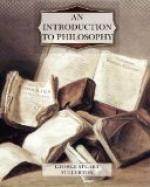Section 53. I have said enough of the Berkeleian idealism in the notes on Chapter XII. As a good illustration of objective idealism in one of its forms I may take the doctrine of Professor Royce; see his address, “The Conception of God” (N.Y., 1902).
Mr. Bradley’s doctrine is criticised in Chapter XXXIV (entitled “Of God"), “System of Metaphysics.”
CHAPTER XIV, section 55. See “System of Metaphysics,” Chapter XVI, “The Insufficiency of Materialism.”
Section 56. Professor Strong’s volume, “Why the Mind has a Body” (N.Y., 1903), advocates a panpsychism much like that of Clifford. It is very clearly written, and with Clifford’s essay on “The Nature of Things-in-themselves,” ought to give one a good idea of the considerations that impel some able men to become panpsychists.
Section 57. The pantheistic monism of Spinoza is of such importance historically that it is desirable to obtain a clear notion of its meaning. I have discussed this at length in two earlier works: “The Philosophy of Spinoza” (N.Y., 1894) and “On Spinozistic Immortality.” The student is referred to the account of Spinoza’s “God or Substance” contained in these. See, especially, the “Introductory Note” in the back of the first-mentioned volume.
Professor Royce is a good illustration of the idealistic monist; see the volume referred to in the note above (section 53). His “Absolute,” or God, is conceived to be an all-inclusive mind of which our finite minds are parts.
Section 58. Sir William Hamilton’s dualism is developed in his “Lectures on Metaphysics,” VIII. He writes: “Mind and matter, as known or knowable, are only two different series of phenomena or qualities; as unknown and unknowable, they are the two substances in which these two different series of phenomena or qualities are supposed to inhere. The existence of an unknown substance is only an inference we are compelled to make, from the existence of known phenomena; and the distinction of two substances is only inferred from the seeming incompatibility of the two series of phenomena to coinhere in one.”
CHAPTER XV, section 60. The reader will find Descartes’s path traced in the “Meditations.” In I, we have his sweeping doubt; in II, his doctrine as to the mind; in III, the existence of God is established; in VI, he gets around to the existence of the external world. We find a good deal of the “natural light” in the first part of his “Principles of Philosophy.”
Section 61. We have an excellent illustration of Locke’s inconsistency in violating his own principles and going beyond experience, in his treatment of “Substance.” Read, in his “Essay,” Book I, Chapter IV, section 18, and Book II, Chapter XXIII, section 4. These sections are not long, and might well be read and analyzed in class.
Section 62. See the note to section 51.




